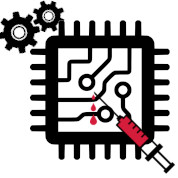Formalizing the Execution Semantics of the Armv6-M Architecture with SAIL
- Typ der Arbeit: Bachelorarbeit
- Status der Arbeit: reserviert
- Projekte: AHA
- Betreuer: Tim-Marek Thomas, Daniel Lohmann
Context🔗
In the CLASSY-FI project we derive constructive methods and techniques for scalable, yet precise and complete FI to experimentally assess the robustness of safety-critical embedded control systems against soft errors A new topic is the consideration of fault injection campaigns in a special setting: as continous integration tests. We try to provide answers for the following questions:
- How can we accelerate fault injection campaigns in the CI context?
- Can we do do this and still ensure accurate (enough) results?
- Are we able to fully verify a component and reuse the FI campaign results for other pieces of software, which include the component?
Problem🔗
We need more complex test applications than simple benchmarks suites such as MiBench1 for the evaluation of our approaches. Especially important is a commit history, which is not provided using standard benchmark suites. Unfortunately, there are not many open-source applications, which target a savety critical domain. However, there are, e.g. flight frameworks for satellites (e.g. 6), and applications like LibrePilot2. Applications like these typically target small ARM boards with CPUs from the Cortex-M series.
FAIL*3, the FI framework used in our project, currently supports two Arm emulation backends: gem5 (Armv8.0-A) and emulators based on SAIL4 models (Armv[8.5,9.3,9.4]-A). SAIL is a imperative language for describing the instruction-set architecture (ISA) semantics of processors. Given a SAIL definition, the tool can generate executable emulators in the C language. So, one can use definitions of different ISAs on the basis of one single tool including type and sanity checking.
Neither gem5 nor SAIL do cover the Armv[X]-M ISA.

Goal🔗
The main goal of this thesis is to implement a SAIL model (and thus ISA definition) for Armv6-M5, and integrate the generated emulator into FAIL*. A generic interface for this was already introduced in previous works (see related theses and the paper below).
More precisely, you are expected to take following steps:
- Literature search: Arm SAIL models, (more) potential tests applications
- Implement the Armv6-M model
- Verify it against a real hardware implementation
- E.g. run several benchmarks from the MiBench benchmark suite and ensure after each step the same state
- Integrate the generated emulator into FAIL*
- Run a fault injection campaign for each of the verification benchmarks
- Optionally also implement a Armv7-M model
Topics: Arm ISA, Sail, (C/C++,cmake)
References🔗
-
SAFECOMP
Conference
B
SailFAIL: Model-Derived Simulation-Assisted ISA-Level Fault-Injection Platforms -
41st International Conference on Computer Safety, Reliability and Security (SAFECOMP 2022)Springer-Verlag2022.
PDF Slides 10.1007/978-3-031-14835-4_14 [BibTex]
Transient-Fault Resilience of a Capability-enabled Processor Plattform
- Typ
- Masterarbeit
- Status
- abgeschlossen
- Supervisors
- Christian Dietrich
Daniel Lohmann - Project
- CLASSY-FI
- Bearbeiter
- Malte Bargholz (abgegeben: 01. Nov 2020)
Formalizing the Execution Semantics of the AVR Instruction Set with the Description Language SAIL
- Typ
- Bachelorarbeit
- Status
- abgeschlossen
- Supervisors
- Christian Dietrich
Oskar Pusz
Daniel Lohmann - Project
- CLASSY-FI
- Bearbeiter
- Luca Nedaskovskij (abgegeben: 16. Oct 2020)
Schotbruch: Automatisierte Ableitung von Injektionsplattformen für transiente Hardwarefehler aus formalen Prozessormodellen
- Typ
- Masterarbeit
- Status
- abgeschlossen
- Supervisors
- Christian Dietrich
Daniel Lohmann - Project
- CLASSY-FI
- Bearbeiter
- Marcel Budoj (abgegeben: 08. May 2019)



